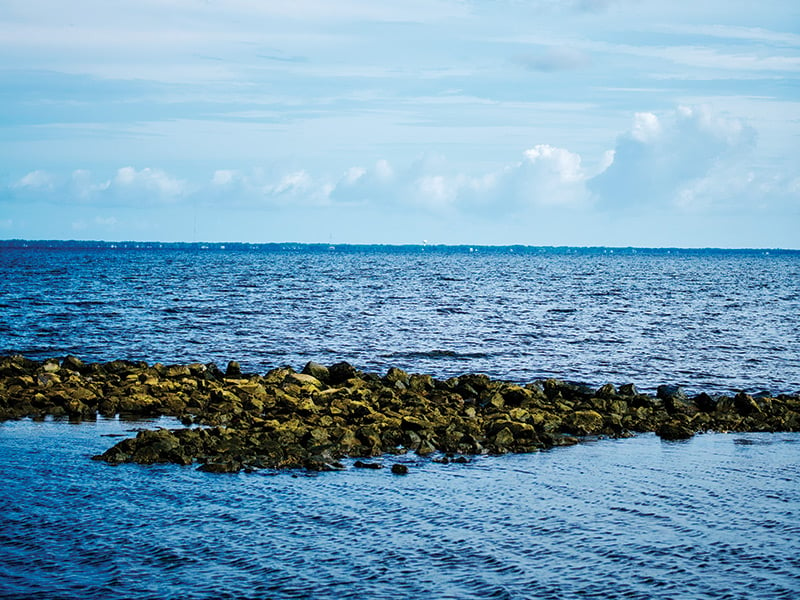Restoring Oyster Reefs
Organizations, community and oyster farmers work to return Pensacola Bay System populations to heyday numbers

An East Coast Floridian, Anne Birch makes regular visits to the Pensacola area to keep tabs on her baby — the Pensacola East Bay Oyster Habitat Restoration Project.
On a June visit, Birch, who previously served as the ocean and coasts strategy director for The Nature Conservancy’s Florida division, hosted a reef tour that would be her last before retirement in August.
Under Birch’s project management, The Nature Conservancy (TNC) facilitated the installation of 33 reefs as part of the Pensacola East Bay Oyster Habitat Restoration Project.
“It means that there’s a real hope for the future,” Birch said of the project’s progress.

Project manager Anne Birch said reef restoration efforts are about more than just increasing oyster populations. “It’s about restoring estuaries back to what they were when they had oysters,” she said. “It’s restoring fisheries, a culture and an economy that was once there.” Photography by Dave Barfield
Oysterman Pasco Gibson has accompanied Birch on her many reef visits and joined us that June day. A career fisherman, Gibson earned his livelihood selling to local restaurants and markets, including the locally loved Nichols Seafood in Milton. Gibson bought the business when the original owners retired, and he continued to stock the inventory with his fresh catches and oyster harvests until selling the business in 2017.
 “It was hopping,” Gibson said of Nichols prior to 2004’s Hurricane Ivan. “We sold oysters for 10 cents apiece. They were plentiful in season — we were catching a lot of them.”
“It was hopping,” Gibson said of Nichols prior to 2004’s Hurricane Ivan. “We sold oysters for 10 cents apiece. They were plentiful in season — we were catching a lot of them.”
The spotlight first fell on Pensacola as a result of TNC’s 2009 Shellfish Reefs at Risk study, which looked at 144 estuaries and 40 ecoregions across the world. Calling oyster reefs “functionally extinct,” the report showed a global estimation that 85% of oyster reefs had been lost.
“Where we can add value is where we want to go,” Birch said, “and Pensacola stood out as one of those areas.”
Where most of the studied estuaries had seen drastic declines of 90–99%, the Gulf Coast showed numbers as low as 50%. But Pensacola showed a 72% decline.
According to Gibson, in the wake of the 2010 Deepwater Horizon oil spill, things worsened before they could get better. However, oil was not the culprit.
“It was due to some poaching that went on with a dredge,” Gibson said. “A couple of rogue oystermen came in here and destroyed a lot of the habitat.”
According to Florida statutes, it is unlawful to use a dredge to remove oysters from natural or artificial state reefs.
“An oyster dredge is like dragging a bulldozer across a pile of dirt — it just flattens it out,” Gibson explained. “This dredge just destroyed that whole mound. There was no habitat left for them to cling to.”
Law enforcement was tied up with the oil spill, and the illegal dredging went unnoticed until several complaints from Gibson and other local oystermen came in. Law enforcement took action, but the damage was done.
Today, Gibson says outdated septic systems are creating water quality issues, slowing the recovery process.
“I’ve spoken before the county commissioners,” Gibson said. “I got stats from the Florida Department of Agriculture Division of Aquaculture, which monitors these bays weekly.”
Still, no changes.
“We’re just not getting anywhere,” he said.
Heading out from Blackwater Bay, tour guide Birch recalls the journey by counting the reefs.
In Fundy Bayou are eight of TNC’s 33 reefs. Turning the bend at Escribano Point, we pass three more. Approaching reef No. 12, we stop for a field trip lesson from expert Birch.
Reef No. 12 was the first test reef constructed in August 2021, making it the most established. The 33-reef project was completed by August 2022.
“Eventually, it would be great if all of it was populated by live oysters,” Birch said. “But that will take many years.”
Still, she wades over and easily locates an inhabited rock for show and tell.
Most of the 33 reefs are within protected areas, but several lie in harvesting zones, as dictated by the Florida Department of Agriculture and Consumer Services Division of Aquaculture.
For wild oysters to breed on their own, they require a reef or structure they can cling to, somewhere to call home.
Oysters reproduce through a process called external fertilization. Into open water, males release thousands of sperm at a time, and females release millions of eggs. Fertilized eggs become free-swimming larvae until they find a reef, shell or surface to cling to. Once attached, they become spat and begin growing and forming their own shells. In about two years, they become fully formed oysters.
“If you let them just grow, they create these beautiful reefs,” Birch said. “They’re awesome little critters.”
Aquaculture oyster farming has become a common practice in the Pensacola Bay System.
Gibson was initially indifferent to the idea but has recently acquired a lease.
“I never thought it was something for me. I’ve always been a wild harvest person,” Gibson said. “I can see now that this is the only way we’re going to have a surplus of oysters again, I believe.”
Most oyster farmers source seed from wholesalers. Gibson will breed his own oysters from locally sourced spawn. He believes this will produce a better quality oyster, as good as they were when he sold them for 10 cents.
“We will have an oyster that is genetically adapted to this area,” he said, “because our oysters were the best in the world.”
Unlike some industries, there’s no beef between environmental restoration organizations and oyster farmers. Aquaculture oyster reefs and wild oyster reefs offer the same benefits of larvae distribution throughout the bay system.
“Any type of oyster reef you put in the water benefits other reefs,” Birch said. “Whether it’s a harvestable reef, reef for habitat or aquaculture, they’re all working together in a system. And the people who are involved in that are all working together as well. I think that’s a really important point, that the harvesters and the aquaculture farmers and the resource managers are all working together on this, they all want the same goal.”
Recent drone footage taken this summer shows high activity within the new reefs. Large schools of fish including trout are frequent visitors.
“That’s a great sign that they like the structure,” Birch said.
“It just builds on the whole ecosystem there,” Gibson added.
Now, all the reefs need is time.

Matt Posner, alongside fellow members of the Pensacola and Perdido Bays Estuary Program, served as project partners with plans to execute future restoration efforts. Photography by Dave Barfield
Still Work to Do
Prior to the reef installation project, The Nature Conservancy (TNC), alongside 20-plus stakeholders, worked over 18 months to facilitate an Oyster Fisheries and Habitat Management Plan for the Pensacola Bay System.
The Pensacola and Perdido Bays Estuary Program was among those stakeholders.
“We adopted that as part of our comprehensive management plan for the Pensacola Bay System,” said Matt Posner, executive director of the Estuary Program.
The plan, finalized in 2021, identifies 600 hectares, or 1,482 acres, where oyster habitats once thrived. The plan approves permitting for reef restoration efforts for up to 100 of the 600 hectares within the Pensacola Bay System. The Pensacola East Bay Oyster Habitat Restoration Project’s 33-reef installation was part of this plan.
“This hasn’t been done before —
to have a permit for a bay system,”
said Anne Birch of TNC.
“We’re able to increase the speed and efficiency of restoration and decrease the costs,” she continued. “That’s what this is about — getting oyster reefs in the water as quickly as we can to start the recovery process.”
With TNC’s 33 reefs established, the organization’s presence will soon come to a close. But the plan is set in motion.
“This project was the catalyst for something larger,” Posner said.
The Estuary Program has received a $10.9 million grant from the National Oceanic and Atmospheric Administration (NOAA) to fund additional outlined projects. The established plan saves them the hassle of the lengthy permitting process, which can take up to two years from Birch’s experience.
“The Estuary Program stepped up,” Birch said. “They’re a perfect partner for implementing the plan because they coordinate and collaborate with partners all over the estuary watershed.”
Posner and the program have a 10-year goal to restore all 600 hectares of oyster reefs that once thrived in the bay system.
“It’s a very ambitious goal, but we know the bay once supported that.”

